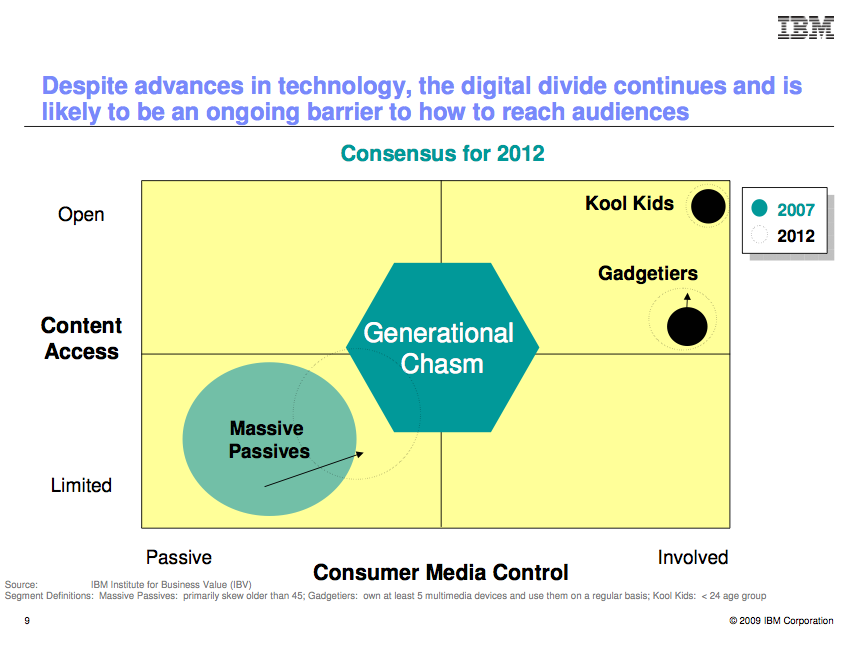We’re spoiled by technology. Today, we expect more from our media than we can get from print, radio or linear TV.
If you’re like me — and, increasingly, evidence shows people are — you crave portability, fungibility, the ability to listen to a book or article, to watch a TV show or movie or YouTube clip whenever and wherever you want. You may even, like me, want to chop off pieces and show them elsewhere, tag them, mash them up.
Consuming media the way it used to be provided (and sometimes still is) can be so woefully inefficient. Who wants to have to sit down and consume at the provider’s convenience, rather than their own? Who has time for appointment TV any more? Just look at the research that finds more and more of us using DVRs, avoiding commercials and otherwise changing viewing habits.
It’s not necessarily that we object to a reasonable level of advertising or fees. We’re increasingly using services like Hulu or Netflix that let us watch shows and movies on demand, even if we have to suffer ads, or pay for the privilege. It’s worth the price in order to not be at the mercy of whatever happens to be available, either in real-time or on-demand through a cable. It’s great to have the choice of what screen to use, too. And who doesn’t enjoy being able to zoom back a minute or two and catch something they liked or missed?
During the Winter Olympics, I couldn’t bother sitting through tape-delayed events that had happened hours ago or that I didn’t care about. I not only recorded the shows off the air, using an Eye TV device mentioned in this MediaShift story on cutting the cord to cable, but also set the program to automatically convert the broadcasts to iTunes clips that took up less space on my hard drive and also made them easy to transfer to computers and other devices.
Shifting from Eyes to Ears and Back
If you’re like me, you also enjoy reading and listening to books you’re interested in. I may read a chapter or two, then listen to a chapter while doing the dishes. I get through the book faster and enjoy the continuity. When an audiobook doesn’t exist — which is surprisingly often — I’ll try to get the digital edition and have my computer’s speech-synthesis application read it to me. Even with the distortions and glitches, it’s good enough to give a good rendering of what’s in print.
I’ll do that for newspaper and magazine articles, blogs and research papers, too. It’s a great way to not have to stop reading because I have something else to do that requires the use of my hands or eyes. If I’m going to be traveling, I might record the audio into an iPod so I can listen while standing in line or taking a taxi to the hotel. I’ll certainly access books remotely via computer, Blackberry or iPod Touch.
By now, you may be thinking: What’s this got to do with trends in media or the media business, at large? This guy is a huge geek, and he’s unlike 90 percent of humanity.
But that really isn’t the case. Yes, I am reasonably comfortable with technology, but I don’t use it for its own sake. I use the technology because it is liberating, it let’s me do things I’ve always wanted to. I know I’m not the only person who’s engaged in time- and place-shifting by using a timer and tape recorder to grab favorite radio shows, for example. It’s no secret why audio cassette decks used to be sold with two slots for tapes, only one of which had a “record” button. I still record things on a videotape when I want to bring them over to someone else’s house to watch.
Our time is valuable, and the more we can control it the more value it has. So, too, does media become more valuable when we can better weave it into our relationships. If we can snag a piece of something and blog or tweet about it or email it to a friend, it makes it easier to have a meaningful conversation and be engaged.
Age of the Participatory Consumer
A recent study from IBM media research found that we’re moving from “traditional devices” to “connected experiences,” that media consumers from all generations, but especially the younger ones, are moving from passive to “involved” consumption of media, and from limited to open access. Consumers around the world, it finds, increasingly expect to control and participate in their media.
There’s a lesson here amid debates about what media consumers will pay for, and which distribution channels and levels of access can be controlled. Device makers, too, need to figure out a balance between portability and access, as the iPod’s masters showed they learned by finally offering DRM-free versions of songs. I also predict the Kindle will do the same as competitors with more open devices gain market share.
Anyone who produces media or the devices to consume them will have to provide enough value for us to put up with any restrictions. More importantly, they need to understand that technology has made us into new kinds of consumers.
Dorian Benkoil is consulting sales manager, and has devised marketing strategy for MediaShift. He is SVP at Teeming Media, a strategic media consultancy focused on helping digital media content identify and meet business objectives. He has devised strategies, business models and training programs for websites, social media, blog networks, events companies, startups, publications and TV shows. He Tweets at @dbenk.
